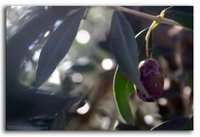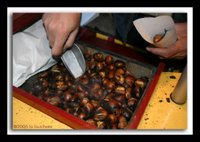 As a child of the sixties, the only olive I knew was black and salty, tough and hollow…if we were lucky - that is to say, lucky if they were hollow. (I wasn’t much into those pits.) There was a long-standing pattern of olives being stolen from my plate at dinner when a particular cousin who, several years older than I, took great pleasure in this little joke. (I should have been happy for those olives to be nipped!) Aside from being rather protective of the food on my plate (something that has stayed with me to this day), I was not the olive lover in my family. That role belonged to my sister. With a pitted olive on each finger, she would slowly nibble them off, savoring them as if there was something really special going on that I simply didn’t understand. Further proof of her love of olives was evidenced by the fact that she would regularly request those fat, sour green olives stuffed with pimento. Ahhh…such was life in the sixties with two little girls who were training their very different palates.
As a child of the sixties, the only olive I knew was black and salty, tough and hollow…if we were lucky - that is to say, lucky if they were hollow. (I wasn’t much into those pits.) There was a long-standing pattern of olives being stolen from my plate at dinner when a particular cousin who, several years older than I, took great pleasure in this little joke. (I should have been happy for those olives to be nipped!) Aside from being rather protective of the food on my plate (something that has stayed with me to this day), I was not the olive lover in my family. That role belonged to my sister. With a pitted olive on each finger, she would slowly nibble them off, savoring them as if there was something really special going on that I simply didn’t understand. Further proof of her love of olives was evidenced by the fact that she would regularly request those fat, sour green olives stuffed with pimento. Ahhh…such was life in the sixties with two little girls who were training their very different palates.Then one year for Christmas, my very frugal (and very creative) parents put a can of California Graber olives in my sister’s stocking. It was a new product and the can opened to show plump globes of mottled green and brown – their pits still tucked in their middles – swimming in a clear liquid instead of the inky stuff that would be drained off of the olives we had known until then.
My sister bravely tucked right into the gift and was kind enough to share – probably feeling confident that the can would remain untouched by me as I had mild gag reactions to green olives. But I must have been feeling adventurous and pulled one from the freshly opened can. The tender flesh released an actual flavor that deserved attention. There was something different going on here: a noticeable richness, a soft green woody-earthy taste that immediately had me asking for more. I can’t remember just how generous my sister was in that particular moment, but I do give her credit for introducing me to something new in the olive realm. Those cans of olives continued to show up in her stockings at Christmas and our tables at holiday time.
Fast forward to many years later and my first trip to Provence: It was during that first "wander’" through the marché in the early morning light along cours Saleya in Nice that I was introduced to the pungent aroma of briny olives that are a staple in Provence. The scent that permeated the air as the vendors dipped into big tubs of olives with wooden ladles to offer samples to passers-by was intoxicating to me. The display from vendor to vendor was a visual feast: small, large, shiny, or not-so-much...in earthy blacks, browns, greens...some mixed with herbs, others mixed with onions and peppers, and preserved in a bath of their own oil. This was a new world and a stash of fresh olives from the marché made it back with me from every trip.

This year, my affair with olives was taken to an even deeper level. I was invited by a new friend to participate in the annual olive harvest of the trees on her property in the countryside just outside of Aix.

Our long hot summer took its toll on the olives this year. With little rain and relentless heat, there were fewer olives on the trees than usual. With a week or so of a Mistral that blew through Aix with a force that I am still getting used to, it was decided that it would be best to go forward with the harvest, even though it was earlier than usual.
There is a regular group that shows up for this annual event made up of friends, neighbors, grown children and their spouses and younger children (one of whom turned out to be a very good “tree shaker”!)

Any and all newcomers are warmly welcomed. Under a “Will Work for Food” contract, they start in the morning with a picnic lunch offered by the “mother” of the trees (and owner of the bastide) at mid-day. After the day is finished and the work completed, there is a lively lasagne dinner for the hungry and friendly crew.

When I arrived, the work had begun.
 People were working below and around the perimeter of the trees. Some were chatting quietly…others were working in silence. There was some sort of collaboration between the people and the trees. Olives that had been blown off the tree were collected from the ground before the nets were spread and the picking began from the olives suspended in the branches.
People were working below and around the perimeter of the trees. Some were chatting quietly…others were working in silence. There was some sort of collaboration between the people and the trees. Olives that had been blown off the tree were collected from the ground before the nets were spread and the picking began from the olives suspended in the branches. 
Some pickers dropped the olives to the net while others worked filling bags or baskets. Larger crates began to be filled with all of the olives collected in preparation for the trip to the olive mill (cooperative) where the owner will retrieve bottles of olive oil when the press is finished. I heard someone say that it should provide enough to last through the year. Mmmmm!

It was lovely for me to catch up with people I’ve not seen since before the summer began. As I worked, I overheard many French conversations between people catching up on each other and mutual acquaintances not present. One woman remarked on how lovely the olives looked as she plucked them from their suspended state within the leaves. “…comme marbre!” (like marble) she said, and I was struck by this lovely woman's appreciation for the simple beauty of these olives. I would have to agree.
All conversations were taking place as a slow-motion dance was performed around the olive trees. It was in this manner that the group moved through the grove. Against a brilliant Provençal blue-lavender sky on a mild October day, the task was happily taken on by all participants. It was my first olive “récolte” (harvest) and I would hope that it is the first of many! (Next time, I’m staying for the lasagne!)
(Merci, Sheila and Margaux, pour cette occasion comme ça! C'etait un plaisir!)
`a la prochaine fois!
L
And to put those olives to good use:
Anne’s Goat Cheese Gratin
 (adapted from At Home in Provence by Patricia Wells)
(adapted from At Home in Provence by Patricia Wells)6 shallow 6-inch (15 cm) round gratin dishes or 1 10.5 inch (27 inch) round baking dish
About 10 ounces (300g) soft goat cheese or a mix of rindless soft goat and cow or sheep’s milk cheese, cubed or crumbled.
2 Tablespoons of your favorite fresh herbs, minced (or dried herbes de provence)
1.5 to 2 cups (33 to 50 cl) your favorite homeade Tomato Sauce at room temperature
About 24 best quality olives, pitted
1. Preheat the broiler
2. Scatter the cheese on the bottom of the baking dish or dishes. Sprinkle with half of the herbs. Sppon on just enough tomato sauce to evenly coat the cheese. Sprinkle with olives and the remaining herbs.
3. Place the baking dish or dishes under the broiler about 3 inches (8 cm) from the heat. Broil until the cheese is melted and fragrant, and the tomato sauce is sizzling, 2 to 3 minutes…although mine always take extra time…watch them closely.
Bon Appetit!










